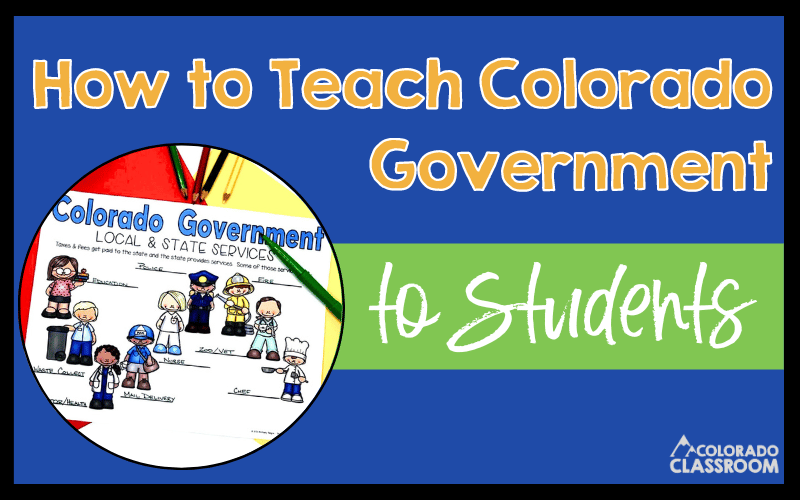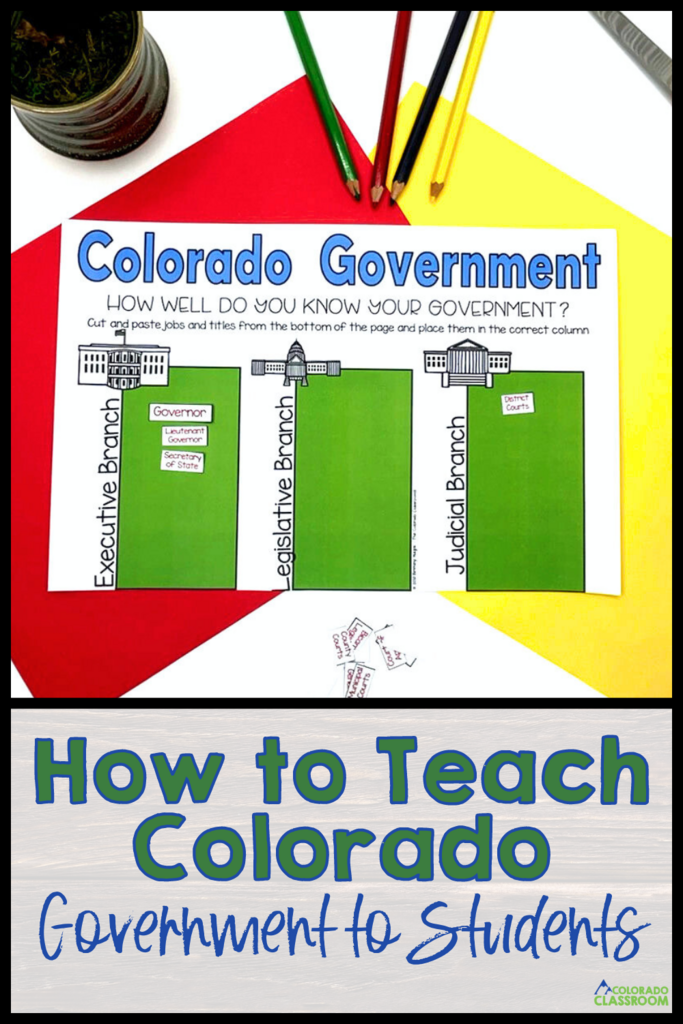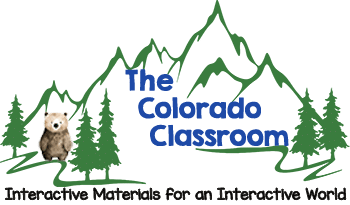10 Engaging Activities to Teach Colorado Government to Students
If you know me at all, you know I’m a big fan of my home state, Colorado! I enjoy any chance to bring the rich history and structure of Colorado to life for my students. But let’s face it, it isn’t all exciting and captivating. As Social Studies or history teachers, we’ve all been there. Sometimes, the facts we’re teaching can be as dry as the desert air. Today, I’m here to up your teaching game and make diving into all things Colorado government engaging!

Overview of the Colorado Government Unit

In this Colorado Government unit, you will be leading your students on a journey through the statehood and government of Colorado with engaging, low-prep lessons! This resource comes packed with 10 activities guaranteed to make learning a breeze. These activities include everything from unraveling the web of government structure to diving into the nitty-gritty of local versus federal control.
This comprehensive unit goes above and beyond to explore the services provided to citizens and the oh-so-important role of citizens in the great state of Colorado. This unit isn’t just limited to pen and paper. This unit is filled with hands-on activities that will get your students doing. All of these are great to add to an interactive notebook, but they can be used as individual pages. I’ve also got a digital version that is perfect for those classrooms that are 1:1 or looking for ways to integrate technology! Let’s take a closer look at each of the activities included!
Becoming a State Flipbook to Kickstart the Colorado Government Unit

Let’s dive into the first activity of this Colorado Government unit, the “Becoming a State” flipbook, or as I like to call it, the stepbook. This resource walks through the history of what it took for Colorado to become a state in the United States. Students will learn about the behind-the-scenes action, the key players, the tough decisions, and most importantly, the ripple effect of those decisions.
From my years of teaching experience, I’ve found that giving your class about 3 to 5 days to tackle this stepbook works well. That’s enough time for the cutting, the gluing, and the discussions about all those historical facts. I usually break it down to about one step of the statehood process per day. You know your students best, so feel free to adjust the pace to suit their needs.
Each part of the step book is neatly labeled, with clear directions on which parts to snip out and assemble for each step along the way. At the bottom of each card, your students will read a little caption of what was going down during that month and year. The information is presented in an approachable manner that doesn’t overwhelm our historians with a lot of extra historical detail. By the time they’re done, your students will have crafted an interactive stepbook that gives an overview of how Colorado earned its spot on the statehood map.
Government Structure Examination

Our next activity is all about unraveling the structure of the Colorado government. We explore the three powerhouse branches: Executive, Legislative, and Judicial. Within all three branches, we get to know the players within each branch and what they bring to the table. We also discuss the similarities with the United States government structure.
Tackling all this info together as a class can be a bit of a brain workout. So, I usually take anywhere from a single day to a few days, depending on the dynamics of the group. To tie it all up together, my students wrap things up with an activity where they’ve got to play detective and figure out which branch each statement belongs to.
This activity is as flexible as you need it to be! You can use it as an exit ticket, a homework assignment, a whole-class activity to wrap up the lesson, or even a partner assignment. It’s all about fitting the needs of your kiddos while getting a solid gauge of just how much they’ve soaked up about the branches of government.
Determine the Branch

I love using this sorting activity either as a center activity or a partner task. It’s a mini challenge that puts my students’ Colorado government knowledge to the test! They start by cutting out all the different job titles from the bottom of the sorting page. Then, they need to sort these titles into their rightful branch of government box.
I always tell my students to hold off on the glue until they’ve shown me their handiwork. That way, if they hit a roadblock or get a bit stumped, we can have a chat about it and easily shuffle things around. It’s all about that flexibility! Plus, it gives me another sneak peek into just how well they’re grasping the ins and outs of the Colorado government branches.
Know the Job Activities

Let’s chat about Know the Job activities. In this activity, my students (and yours!) get to flex their knowledge muscles by explaining the ins and outs of key positions within the Colorado government.
There are two versions of this activity to cater to different learning styles. Version one features three lines each for the Governor and two other positions of their choice. Beneath each line, there’s a box where they can jot down their thoughts or even get artsy with a sketch illustrating the roles and purposes of each position.
Version two keeps the three lines for the Governor and two other titles, but instead of boxes, it offers more lines for explaining the roles and purposes of each position. It’s all about giving our kiddos options! Some thrive with structured lines to write down their ideas, while others prefer the freedom of extra space for brainstorming or doodling.
Examine Who’s in Control
When it comes to this activity, we are diving into all the different levels of government and who has control over what. It’s here where we learn how the Colorado government fits in with everything else. After talking about the different levels of government we work our way down the pyramid to talk about who is in control of us. We take a look at a pyramid structure, and we start from the top and work our way down.

First up – You. This one is a real eye-opener. Surprisingly, a lot of my students don’t see themselves as players in the grand scheme of government. There are always great conversations when we unpack this! We chat about how each of us holds the reins to our own behavior every single day. It’s all about making the right choices, following the rules, and deciphering what’s right versus wrong.
The next layer is the city government and the city council. Do you have a bone to pick with your neighbors? Your local government steps in, with the City Council, Mayor, or governing board ready to listen.
The third layer is the county seat, which involves the county sheriff. He or she becomes involved when situations or issues cross city lines or become complicated in general.
Next in line is the state government. We chat about how these folks, including the state courts and the governor, only step in when things get seriously important or impact the state as a whole. They become involved when you’ve exhausted every other avenue to fix whatever’s gone haywire.
The final layer of the pyramid is the federal government. None of my students are surprised by this one because they have some idea of how the President, Supreme Court, and overall federal government oversee our country and how our country interacts with other countries in the world.
Laws Activity

Now that we have a better understanding of who is in charge at the different levels of government, the next step is to learn about the types of laws each level has the authority to pass. This activity walks my students through what the differences are between the local, state, and federal laws.
We talk about how local laws focus on matters that are relevant to the local area. A local law example could be about the speed limits within a neighborhood. State laws address matters that involve the state. State law can override local law when needed as long as it’s connected to a state matter. An example of a state law would include the possibility of kids riding scooters on highways. Federal laws only have power when the federal government is involved. They overrule state or local laws that connect to a federal matter. For example, flying a drone over 500 feet in the air.
Once we have a good handle on the three types of laws, we take a closer look at laws relevant to the Colorado government (local and state) and then federal law. Our kiddos read the law and then check off whether it’s local, state, or federal.
Responsibility Activity
This is one of my favorite activities while teaching Colorado government. My students absolutely love these scenarios. In this activity, we explore who takes responsibility when life throws a curveball our way.
We read through each scenario and decide who is in charge of handling this situation. Then, we return to our trusty pyramid, which starts with you at the top and ends with the federal government at the base. As we chat through each scenario, we write down our labels, pinpointing which level of responsibility each one falls under. Sometimes, we have that lightbulb moment where we realize that a situation might stop with our local government or it could go straight to the federal government.
Identify the Services Activity

Our next topic of study is local and state services. We kick things off by chatting about how folks pay taxes and fees to the state so that the state can provide essential services for everyone. We’re talking about the real heroes of our communities here, such as the teachers, mail carriers, police officers, doctors, firefighters, and even the unsung heroes of trash collection. Many times, this lesson is the first time students realize that these service positions are funded and paid for by the government.
To make sure my students really get the lowdown on each service, I’ve dedicated a whole anchor page in the unit to break down the details. Then, I hand out a page of foldable rectangles for my students to cut out, fold, and glue right into their interactive notebooks. Each rectangle provides info about a different service. Right above the description is a space where they can sketch out an illustration that brings the service to life.
Explain the Services Activity
To take a deeper dive into services, I have a few activity pages where students need to explain when and how they used the service being described. They start by reading a short description of what the service involves. Then, underneath, there is plenty of space to write out responses to the reflection questions about how they have used these services in their own lives!
Citizens and Their Roles Activity

As we near the finish line of our Colorado government unit, we focus on the real MVPs, which are the citizens. This is where my students get to ponder what it means to be a citizen and how they fit in.
We kick things off by tackling some questions about what being a citizen means to them. It’s all about getting their perspective and learning what citizenship truly entails.
Next, we begin a brainstorming session. We’re talking about all the actions and deeds that citizens can take to make a difference in their communities. From small acts of kindness to larger-scale initiatives, every action counts!
We wrap things up by thinking about the future. We’re thinking about how citizens can be the driving force behind positive change in their local, state, and even national communities. And. . . I make sure that my students know that this includes them. It’s all about empowering them to realize the power they hold in their hands to shape the world around them.
Bring Colorado Government to Life in Your Classroom
As we wrap up our tour of the Colorado Government unit, I can’t help but feel a sense of excitement for you to start this unit in your classroom! From uncovering statehood to diving into the roles of citizens, each activity has been a chance for my students and me to connect, learn, and grow. Through interactive lessons, discussions, and hands-on activities, we’ve not only explored the ins and outs of our government but also discovered the power that each of us holds as citizens. I’m confident about the bright futures ahead, knowing that our students are equipped with the knowledge and passion to be active participants in shaping our world for the better.
Additional Resources for Teaching About Colorado
Looking for more resources to build your Colorado unit? Take some time to explore the following posts:
Save These Ideas for Teaching Colorado Government
Remember to save this post to your favorite teacher Pinterest board to help you plan for your Colorado government unit!

